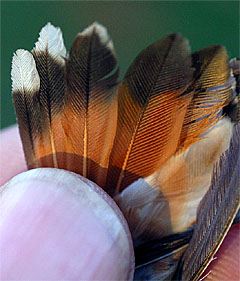|
|
|||
|
RUFOUS HUMMINGBIRD |
|
All text & photos © Hilton Pond Center We first met Lamar Ashe long ago at a presentation we gave to the Gaston (NC) Audubon chapter he helped run. Over the years he and his wife Brenda have traveled in the U.S. and internationally in search of new species. Even though their suburban backyard just south of Gastonia is a wildlife haven that has hosted everything from Eastern Screech-Owls to rarely seen warblers, Brenda had always hoped a winter vagrant hummingbird would someday visit their feeder. Other homeowners in Gaston County have been fortunate enough to have Rufous Hummingbirds and even a Calliope, but Brenda and Lamar weren't so lucky. Until 1 December 2003, that is.
On that morning, the Ashes looked out their back window and for a split second saw the unexpected sight of a tiny bird with whirring wings. Excited by the opportunity to add another species to their yard list, they spent the next couple of days trying to get a better look. The hummingbird was very skittish, darting away at the slightest movement inside the house, but by 5 December both Lamar and Brenda had seen the bird well enough to announce they had what appeared to be a young male Rufous Hummingbird. Since Gaston County is just across the border from York County SC--the home of Hilton Pond Center--we quickly contacted Lamar and arranged for a banding attempt at dawn the next day.
We drove the short 20-mile trip from York to Gastonia on 6 December and arrived at 6:45 a.m., after which we moved Lamar's feeder into our portable hummingbird trap and re-hung the apparatus outside the back window. Then we went inside and darkened the room behind us, waiting for the sun to come up and the hummingbird to appear. Over the next half hour we chatted about some of the trips Lamar and Brenda had been on--especially one to Hawk Mountain Sanctuary in Pennsylvania where we once served on staff. Finally, at 7:43 a.m. the anticipated hummingbird hove into view, spent a couple of minutes figuring out the trap, and entered to drink. Within a second or two after we hit the remote release that closed the trap door, everyone jumped to go outside for a better view.
As we approached the trap there was no doubt this was a young male Rufous. The combination of rust at the base of its flared tail and in many places on its back was a diagnostic characteristic. Nonetheless, we took the bird inside for the usual measurements (below) and to apply a tiny aluminum leg band inscribed with #14856.
Following the banding operation, we took the hummer outside so that Brenda and Lamar Ashe could hold and examine this new yard bird up close. And, after we hand-fed it, Lamar released this western vagrant hummingbird and watched it speed out of sight, complete with a metal band that may help us track its wanderings in the months to come.
Vital Statistics for All text & photos © Hilton Pond Center
If you're interested in sharing your hummingbird observations and learning from other enthusiasts, you may wish to subscribe to Hummingbird Hobnob, our Yahoo!-based discussion group. Also be sure to visit our award-winning Web site for Operation RubyThroat: The Hummingbird Project; on it you'll find almost anything you want to know about hummingbirds, including more information about Hummingbird Banding.
For much more information about hummingbirds, visit Operation RubyThroat: The Hummingbird Project  |
|
Make direct donations on-line through
Network for Good: |
|
|
LIKE TO SHOP ON-LINE?
Donate a portion of your purchase price from 500+ top on-line stores via iGive: |
|
|
Use your PayPal account
to make direct donations: |
|





 As it turns out, this hummer was quite healthy and weighed in at a hefty 4.0g--about half a gram heavier than most of the winter Rufous Hummingbirds we encounter in the Carolina Piedmont. In addition, he was fairly far along in molting his body feathers from green to brown, indicating he probably hatched rather early during the breeding season in southern Alaska, western Canada, or the northwestern U.S. The base of his tail was quite rusty for more than half its length, both on the dorsal side (below left) and from underneath (below right), and his cheeks also had that tell-tale rufous glow. With this much rusty coloration, we were bit surprised he had only six of his metallic orange-red gorget feathers.
As it turns out, this hummer was quite healthy and weighed in at a hefty 4.0g--about half a gram heavier than most of the winter Rufous Hummingbirds we encounter in the Carolina Piedmont. In addition, he was fairly far along in molting his body feathers from green to brown, indicating he probably hatched rather early during the breeding season in southern Alaska, western Canada, or the northwestern U.S. The base of his tail was quite rusty for more than half its length, both on the dorsal side (below left) and from underneath (below right), and his cheeks also had that tell-tale rufous glow. With this much rusty coloration, we were bit surprised he had only six of his metallic orange-red gorget feathers. ..
..


 Students at GLOBE-certified schools may submit winter hummingbird observations as part of Operation RubyThroat and GLOBE. Students can also correlate hummingbird observations with data on abiotic factors, including atmosphere, climate, hydrology, soils, land cover, and phenology. See the
Students at GLOBE-certified schools may submit winter hummingbird observations as part of Operation RubyThroat and GLOBE. Students can also correlate hummingbird observations with data on abiotic factors, including atmosphere, climate, hydrology, soils, land cover, and phenology. See the 


